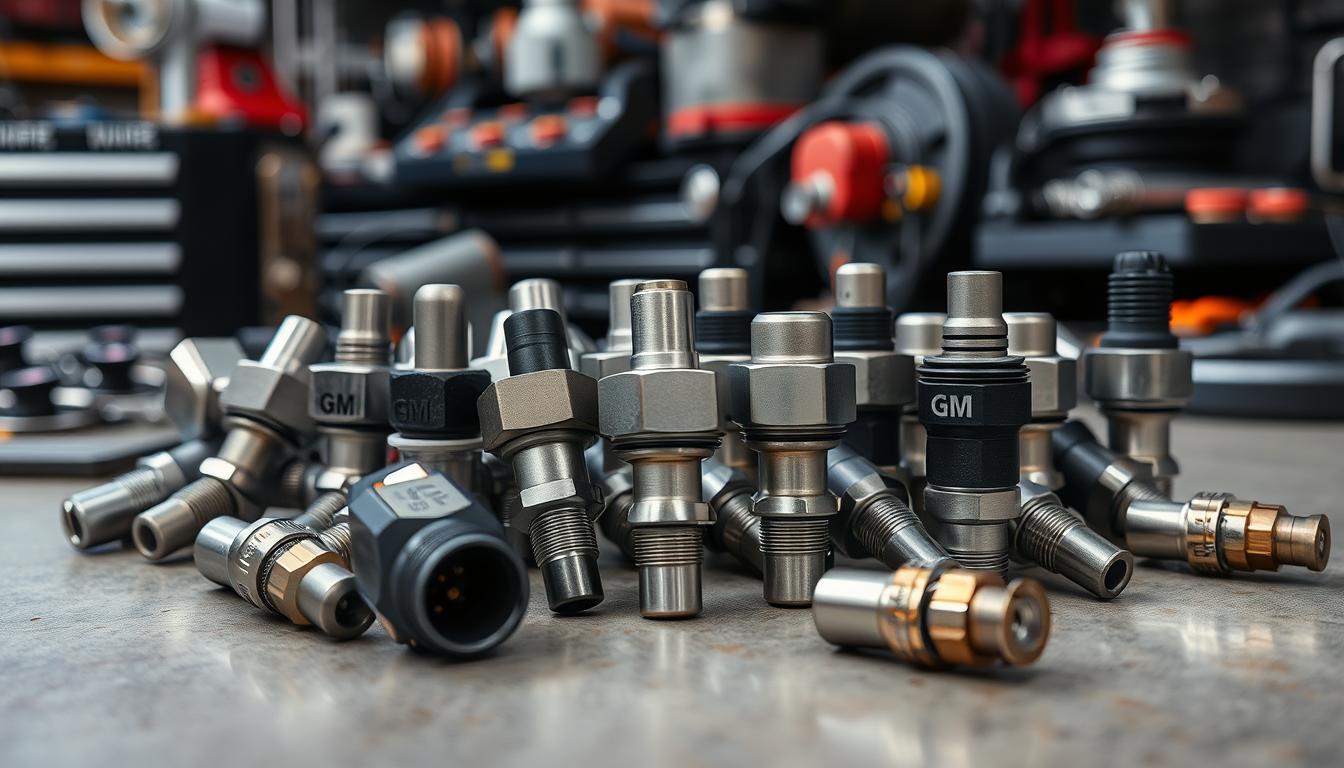Keeping your tires at the right pressure is key for safe driving. The Tire Pressure Monitoring System (TPMS) in your General Motors (GM) vehicle is crucial. But when it’s time to replace TPMS sensors, you might wonder if they can be swapped between different models.
This guide’ll look at what makes GM TPMS sensors interchangeable. We’ll also cover the models that use these sensors and offer tips for keeping your vehicle’s TPMS system in shape.
Key Takeaways
- GM TPMS sensors are generally interchangeable, but factors like manufacturer specifications, model year, and sensor technology can affect compatibility.
- The main requirement for interchangeability is the 315 MHz frequency, which is shared by most GM TPMS systems.
- GM TPMS systems on various models like Buick, Pontiac, Chevy, GMC, and Cadillac share similar relearn procedures and behaviors, with few exceptions.
- Checking part numbers and visual identification can help determine the correct TPMS sensors for your GM vehicle.
- Professional installation is recommended to ensure proper TPMS sensor programming and system function.
Understanding GM TPMS Sensors
General Motors’ (GM) vehicles have a Tire Pressure Monitoring System (TPMS). This system keeps drivers updated on their tire pressure. It’s key for safety and efficiency. Let’s explore GM TPMS sensors and their role.
What is a TPMS Sensor?
A TPMS sensor is in each tire of a vehicle. It checks the tire’s air pressure and temperature. It has pressure, temperature, and acceleration sensors, a radio transmitter, receiver, and battery. GM says these sensors last 10 years or 150,000 miles.
Importance of TPMS in Vehicles
The TPMS system in GM cars uses the same antenna and receiver as the keyless-entry system. It’s usually in the glass or a dedicated antenna. This system is vital for keeping tire pressure right. It affects fuel efficiency, ride quality, and safety.
Overview of GM TPMS Models
TRW, Schrader, and VDO make GM TPMS systems. These systems work similarly and can be swapped in many GM models. The type of TPMS sensor in GM cars depends on the model year and maker.
| GM Model | Years Equipped with Schrader TPMS Sensors |
|---|---|
| Chevrolet Aveo | 2007-2011 |
| Chevrolet Cobalt | 2007-2010 |
| Chevrolet Corvette | 2007-2013 |
| Chevrolet HHR | 2007-2011 |
| Chevrolet Impala | 2007-2013 |
| Chevrolet Malibu | 2007-2012 |
This table shows GM models with Schrader TPMS sensors in recent years. The exact TPMS sensor used can change depending on the model year and maker.
The image shows a GM TPMS sensor. It highlights its main parts and how it works.
Factors Affecting Interchangeability
When looking at GM TPMS sensors, several important factors come into play. These include manufacturer specs, model year changes, and different sensor technologies. All these elements decide if a sensor can work across various GM models.
Manufacturer Specifications
GM vehicles often use sensors from suppliers like TRW, Schrader, and VDO. Each sensor has a unique ID number. This number must be programmed into the vehicle’s Body Control Module (BCM) when it’s replaced.
The key spec to remember is the 315 MHz frequency. This is the standard for GM TPMS sensors. Sensors at other frequencies, like 433 MHz, might not work right and could mess up the system.
Model Year Differences
The model year also matters for the TPMS sensor swap. GM has updated its sensor designs over time. This means sensors from different years might not fit or work together.
For example, sensors for 2005-2007 models cost around $70 from Hong Kong. But 2008 models start at about $120. This shows the price and tech differences between years.
Sensor Technology Variations
GM has used both direct and indirect TPMS systems. Each system has its sensor designs and needs. It’s important to match the replacement sensor with the original technology for the system to work right.
In short, when swapping GM TPMS sensors, check the specs, model year, and tech type. This ensures the new sensor fits and works well with the vehicle’s TPMS.
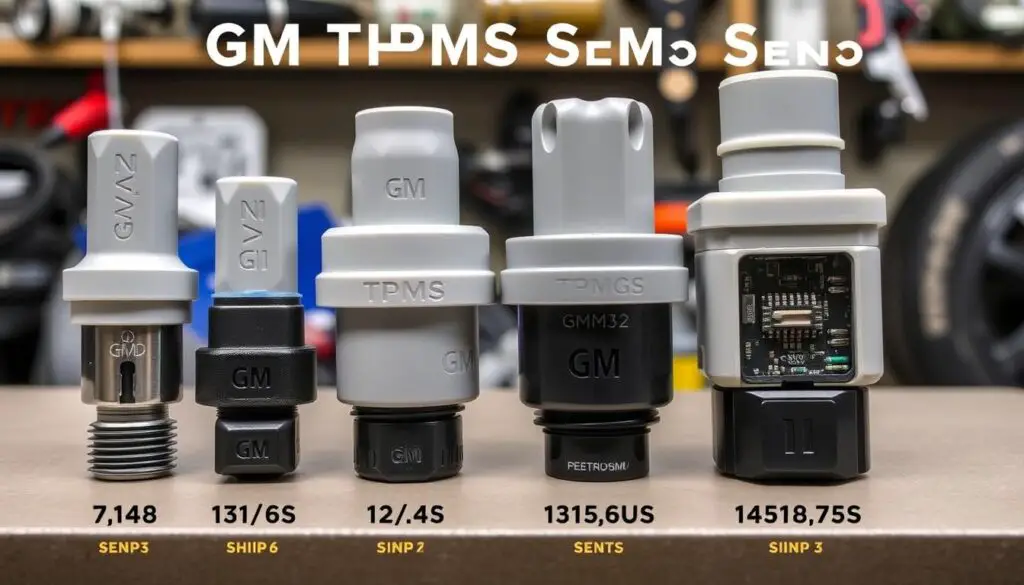
Common GM Vehicles with TPMS
General Motors (GM) vehicles, like Buick, Pontiac, Chevrolet, GMC, Cadillac, and Hummer, have had Tire Pressure Monitoring Systems (TPMS) since 2007. TRW, Schrader, or VDO make these systems. They help keep an eye on tire pressure and manage it well.
Chevrolet Models
Chevrolet cars like the Cruze and Colorado need special steps when changing or fixing TPMS sensors. For instance, the Chevrolet Silverado used Schrader TPMS sensors from 2004 to 2006. Then, it switched to Schrader or TRW in 2007 and back to Schrader from 2008 to 2020.
GMC Models
Like the Sierra and Yukon, GMC trucks and SUVs also have TPMS sensors. The GMC Sierra used Schrader sensors from 2004 to 2006, then Schrader or TRW in 2007. From 2008 to 2020, it used Schrader again. The GMC Yukon, from 2004 to 2022, had Schrader sensors.
Cadillac and Buick Models
Cadillac and Buick cars in GM’s lineup also have TPMS systems. Knowing the right sensor types and how to relearn them is key for service or replacement. This ensures the system works right and gives accurate tire pressure readings.

For all GM brands and models, TPMS sensors are crucial. They help keep tires inflated, save fuel, and make driving safer. Following the manufacturer’s advice is important for the TPMS system’s long life and best performance.
Types of GM TPMS Sensors
General Motors vehicles have two types of Tire Pressure Monitoring System (TPMS) sensors: direct TPMS and indirect TPMS. Knowing the difference between these is key for replacing or keeping your GM vehicle’s TPMS components in good shape.
Direct TPMS vs. Indirect TPMS
The direct TPMS system in many GM models checks each tire’s air pressure and temperature. It uses sensors on the wheels that send data to the car’s computer. This lets you know the exact condition of your tires in real time.
The indirect TPMS system, on the other hand, guesses the tire pressure by looking at how fast the wheels spin. It doesn’t need special sensors. Even though it’s cheaper, it might not be as accurate or quick as direct TPMS.
OEM vs. Aftermarket Sensors
GM TPMS sensors can come from the original equipment manufacturer (OEM) or the aftermarket. OEM sensors fit your car perfectly, ensuring it works best. Aftermarket TPMS sensors might cost less, but make sure they fit your GM model to avoid problems.
Battery-Operated Sensors
GM’s TPMS sensors run on batteries, lasting about 10 years or 150,000 miles. When the battery wears out, you must replace the sensor to keep the TPMS working right.
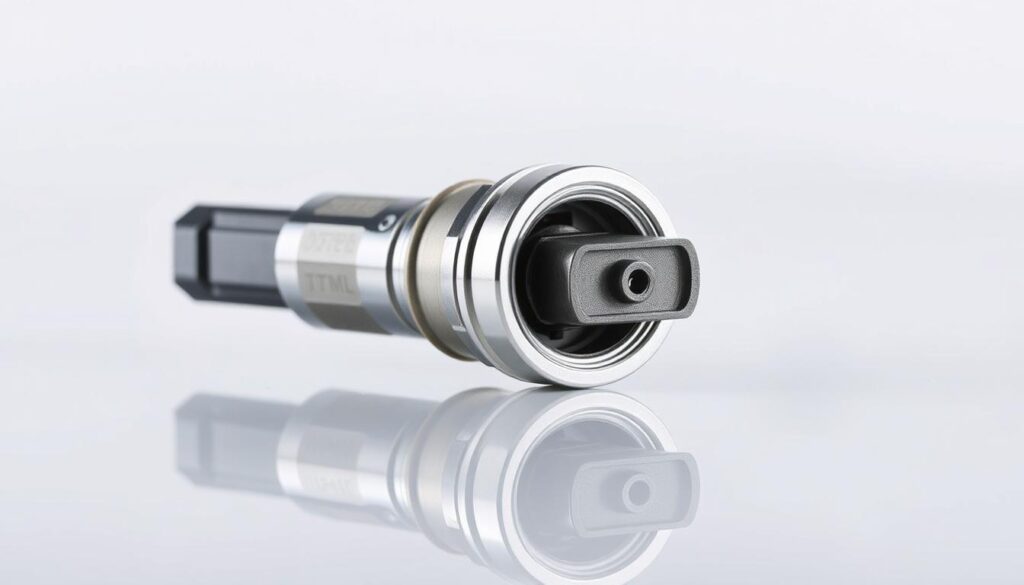
Compatibility Between GM Models
GM TPMS sensors can be swapped between models, but it’s not always easy. Many sensors, like those on the 315 MHz frequency, are made to work the same way. This makes it easier for GM owners to find replacement sensors.
But, not all GM models can use the same TPMS sensors. Things like design, year, and vehicle needs can stop sensors from working. Always check if a sensor will work with your car before buying or installing it.
Similar Sensor Designs
GM TPMS sensors often look and work the same. They’re usually the same size and mount the same way. This makes it easier to swap sensors between GM cars as long as they fit the car’s needs.
Cross-Model Interchangeability
Many GM TPMS sensors, like those on the 315 MHz frequency, can be used on different models. This is true for cars of the same brand or year. But always check the sensor’s fit, as different models might need different things.
Limitations in Compatibility
Even though many GM TPMS sensors can be swapped, there are limits. Some models need special sensors or features that can’t be easily changed. Also, new technology can prevent older models’ sensors from working with newer ones.
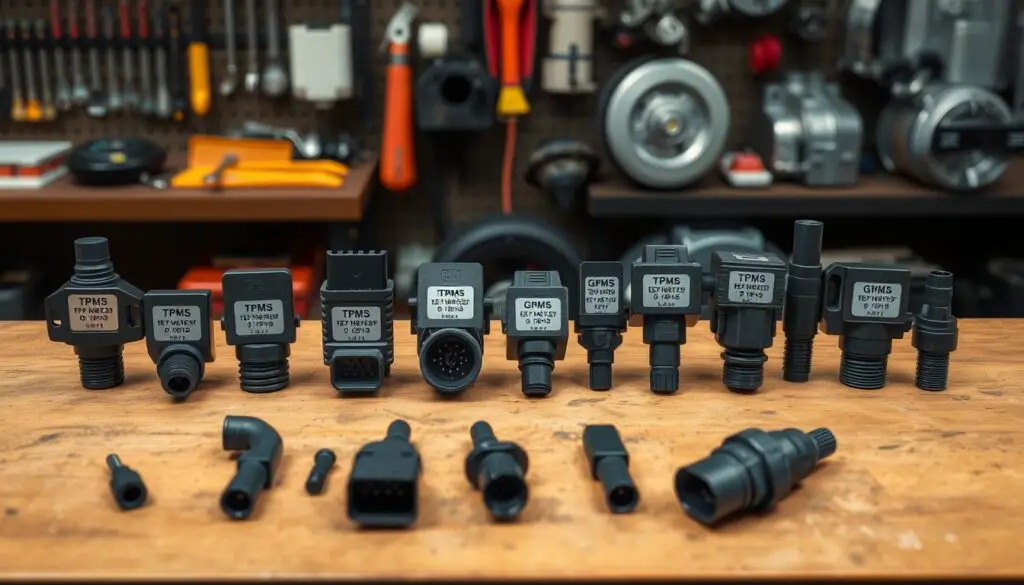
In short, while many GM TPMS sensors can be swapped, you must check the car’s needs first. Making sure the sensor fits right is key to avoiding problems or safety issues.
How to Identify GM TPMS Sensors
Finding the right GM TPMS (Tire Pressure Monitoring System) sensors is key to your car’s health. Luckily, there are a few easy ways to differentiate different GM TPMS sensor models.
Importance of Part Numbers
Part numbers are the main way to spot GM TPMS sensors. They tell you exactly which sensor fits your car. In many Chevrolet, GMC, Buick, and Cadillac models, you’ll find part numbers like 13598771, 19383800, and 19383804.
Visual Identification Tips
You can also tell GM TPMS sensors apart by how they look. Their shape, size, and color can give clues. For instance, Schrader-branded sensors are round, while VDO and TRW sensors are more square.
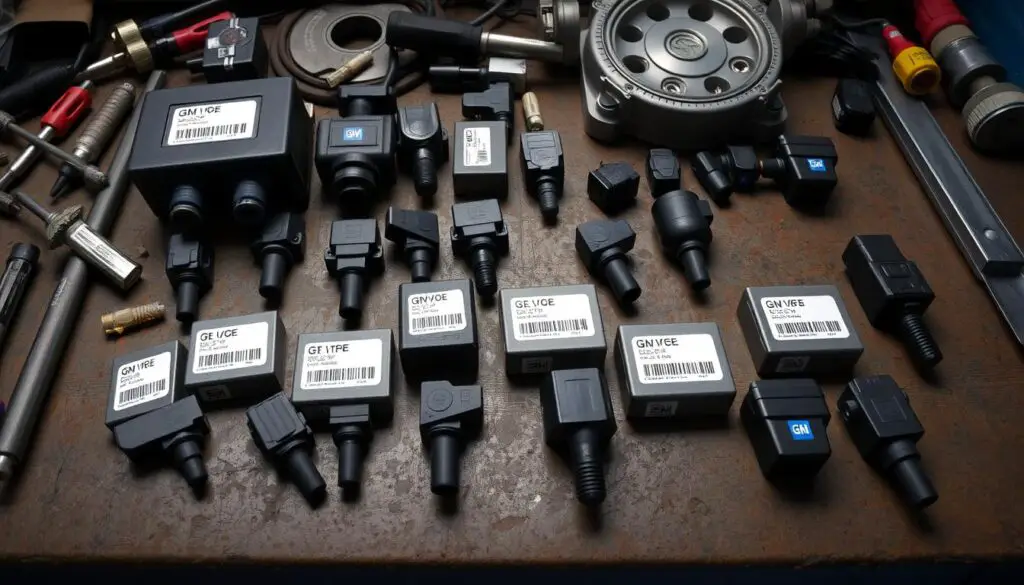
Knowing these visual signs and part numbers helps you pick the right GM TPMS sensor for your car.
Installation of GM TPMS Sensors
Keeping your GM vehicle’s Tire Pressure Monitoring System (TPMS) in top shape is key. You can install the TPMS sensors yourself or get help from a pro.
DIY Installation Steps
If you’re good at basic car care, installing GM TPMS sensors can save you money. Here’s what you need to do:
- Find the right TPMS sensor for your car using the part number or looking at it.
- Please take out the old sensor carefully, remembering how it was aligned and tight.
- Put a special tire lubricant on the new sensor’s parts, not grease or petroleum.
- Put the new sensor in the right spot and screw it in tight, making sure it fits well.
- Match the new sensor with your car’s system, following your owner’s manual or a TPMS relearn tool.
Professional Installation Recommendations
If you’re unsure about installing TPMS sensors or want a pro, that’s a good choice. A trusted mechanic has the skills and tools to do it right, avoiding future problems.
Getting your TPMS sensors installed correctly is vital for your car’s safety. Always follow the manufacturer’s instructions or get professional help when needed. This way, your GM TPMS sensors will work well, keeping your tires at the right pressure.
Troubleshooting Common TPMS Issues
GM TPMS sensors can face problems as they get older. These include sensor malfunctions and warning light issues. Knowing how to reset the system and check sensor readings is key to solving these problems.
Sensor Malfunctions
TPMS sensors usually last about 10 years or 150,000 miles. But they can still have issues. If a sensor doesn’t work, try another one to see if it’s the problem. Also, updating the TPMS tool software can help fix sensor problems.
Warning Light Reset Procedures
Resetting the TPMS warning light requires a special relearning process. For GM vehicles, start with the driver-side front tire, then the passenger-side front, and so on. Do this away from radio signals and aim the tool at the valve stem.
Checking Sensor Readings
TPMS sensors check pressure every 30 seconds when the car is still. If a reading changes by more than 1.2 psi, it becomes learning mode. Knowing your vehicle’s production year helps get accurate readings.
Fixing GM TPMS troubleshooting, TPMS warning light reset, and TPMS sensor readings is vital for your GM vehicle’s safety. By knowing how to handle these common problems, you can keep your TPMS system working right.
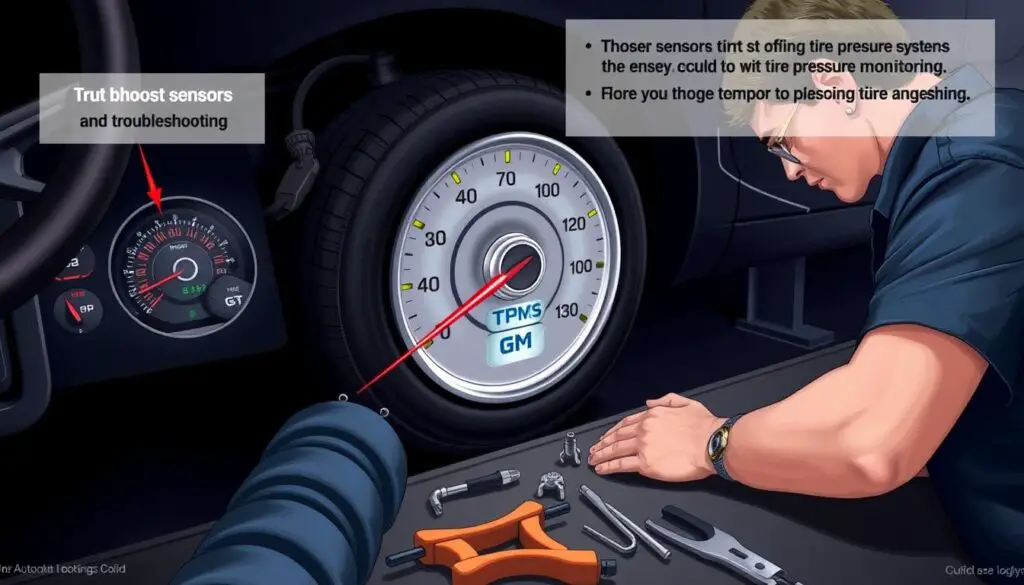
| Troubleshooting Tip | Recommendation |
|---|---|
| Sensor Activation | Try activating a different sensor to determine if the issue is sensor-specific. |
| Warning Light Reset | Follow the specific relearn procedure in the order: driver side front, passenger side front, passenger side rear, driver side rear. |
| Sensor Readings | Confirm the production year using the 10th digit of the VIN to ensure accurate vehicle data. |
Cost Considerations for GM TPMS Sensors
Keeping your GM vehicle’s Tire Pressure Monitoring System (TPMS) in check is important. OEM GM TPMS sensors usually cost about $60 each. But you can find aftermarket sensors for much less, often under $20.
Price Range for OEM Sensors
GM TPMS sensors have part numbers like 13586335 and 13598771. These OEM sensors fit perfectly with your GM vehicle. They ensure accurate tire pressure readings and reliable performance. Even though they cost more upfront, they offer quality and a direct fit.
Aftermarket Options Overview
Are you looking to save on TPMS sensor costs? The aftermarket has many options. Brands like Schrader and VDO offer sensors for various GM models. These sensors can be as cheap as $25 each, making them cost-effective.
Cost-Saving Installation Tips
The cost of installation also matters. You can save on labor by doing it yourself if you’re handy. Just make sure you have the right tools and follow safety guidelines. If you prefer a pro, look for independent shops that charge less than dealerships.
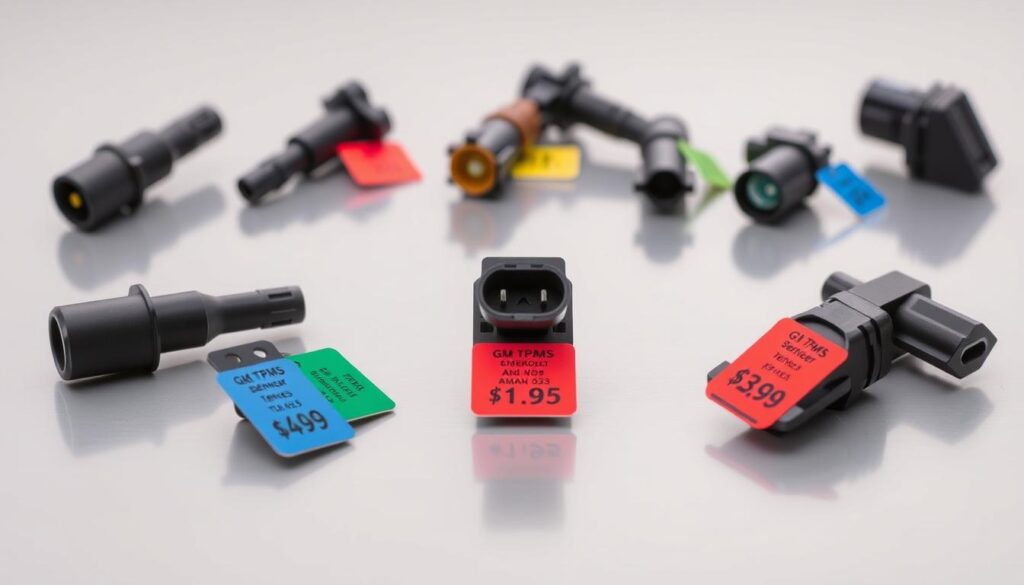
GM owners can save money by weighing OEM vs. aftermarket sensors and DIY vs. professional installation. This way, you can keep your vehicle efficient and safe without breaking the bank.
Maintaining GM TPMS Sensors
Keeping your General Motors (GM) Tire Pressure Monitoring System (TPMS) sensors in good shape is key. These sensors are important for checking your vehicle’s tire pressure. They alert you to any problems.
Regular Maintenance Tips
To keep your GM TPMS sensors working well, follow these tips:
- Check your sensors for wear or damage, like cracks or leaks.
- Make sure the sensors are correctly placed and secured on the wheels. Misalignment can cause problems.
- Do a TPMS sensor relearn after any tire rotation or sensor change? This keeps the system accurate.
- Replace sensors that don’t work with activation tools or show other malfunctions.
Signs of Wear or Damage
GM TPMS sensors usually last 10 years or 150,000 miles. They may wear out or get damaged over time. Look out for:
- Less response to TPMS tools
- Unstable or wrong tire pressure readings
- Physical damage, like cracks or corrosion
- Not sending data to the TPMS system
When to Replace Sensors
Replace your GM TPMS sensors if you see any wear or damage signs. Or if they’ve reached their lifespan. Replacing them can prevent issues like the TPMS warning light coming on or wrong tire pressure readings.
Following these tips and acting quickly on sensor issues can keep your vehicle’s tire pressure monitoring system reliable and long-lasting.
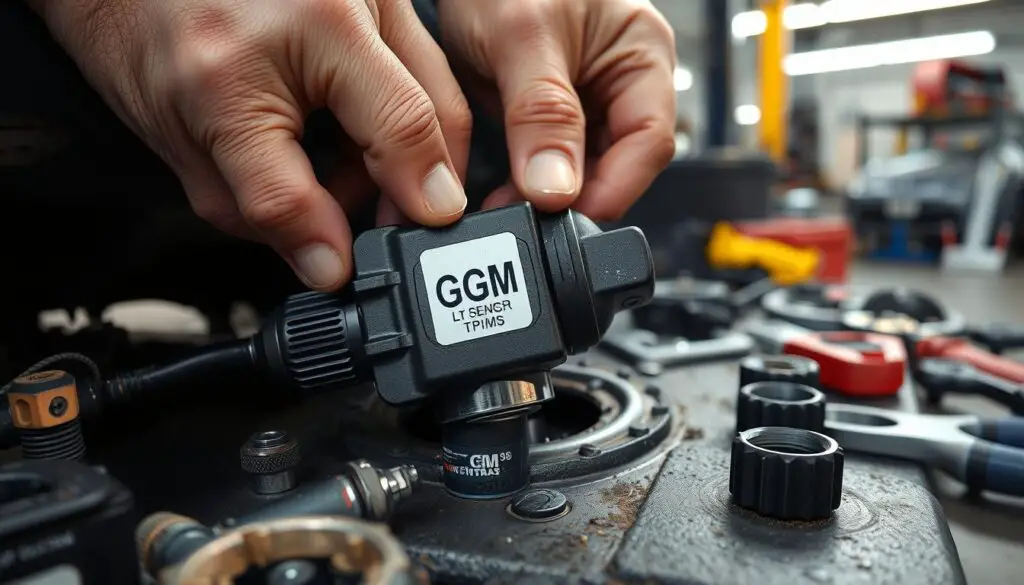
FAQs About GM TPMS Sensors
If you own a GM vehicle, you might wonder about your Tire Pressure Monitoring System (TPMS) sensors. Let’s explore some common questions. This will help you understand and manage your TPMS better.
Can I Mix Different Brands of TPMS Sensors?
While mixing different brands of TPMS sensors is possible, it’s not always the best choice. Mixing tpms brands can cause problems. It might lead to incorrect tire pressure readings. Use the same brand of sensors for your vehicle’s TPMS system for the best results.
What Happens If I Don’t Replace a Malfunctioning Sensor?
If a GM TPMS sensor in your GM vehicle is not working right, you should replace it quickly. Not doing so can lead to wrong tire pressure readings. This can affect your vehicle’s safety and performance.
Ignoring a faulty sensor can also turn on the TPMS warning light. This light shows there’s a problem that needs fixing.
How Often Should I Check My TPMS?
- Checking your TPMS sensors regularly is key for your GM vehicle’s system to work well.
- Check your TPMS sensors during seasonal tire changes or when the temperature changes. These changes can affect tire pressure readings.
- Also, a TPMS system check should be performed during routine maintenance, like oil changes or inspections. This ensures everything is working right.
By answering these common GM TPMS sensor faqs, you can keep your GM vehicle’s TPMS system reliable. This will help you stay informed about the health of your tires. Remember, taking care of your TPMS can improve safety, fuel efficiency, and driving experience.
Conclusion: Choosing the Right GM TPMS Sensor
Choosing the right TPMS sensors for your GM vehicle is key. You should think about compatibility, cost, and how long they last. This ensures your TPMS works well without any issues.
Final Thoughts on Compatibility
GM TPMS sensors are made for specific GM vehicles. It’s important to pick sensors that match your car’s make, model, and year. Going for OEM sensors is a safe bet, but aftermarket ones can be cheaper if they fit right.
Recommendations for GM Owners
For GM TPMS sensor selection, check your owner’s manual or ask a pro. This helps you pick the right sensors. Also, follow the steps to get your TPMS system working right after you replace the sensors.
Resources for Further Information
For more on the TPMS compatibility guide and GM TPMS resources, look at trusted car sites, manufacturer websites, and repair shops. Being informed helps keep your GM vehicle’s TPMS system in top shape.
FAQ
Are GM TPMS sensors interchangeable across different models?
What is a TPMS sensor?
What are the common GM models that use TPMS systems?
What factors affect the interchangeability of GM TPMS sensors?
What types of TPMS sensors are used in GM vehicles?
How can I identify GM TPMS sensors?
Can I mix different brands of TPMS sensors on my GM vehicle?
What happens if I don’t replace a malfunctioning TPMS sensor?
How often should I check my GM TPMS?

Jack Thompson is a writer and seasoned auto mechanic with over 15 years of experience in the automotive industry. Known for his expertise in vehicle mechanics, Jack has a deep understanding of car and truck systems. His skills, honed through years of hands-on experience, have made him a trusted name in the field. Jack is committed to providing valuable insights into car maintenance and repair, helping vehicle owners keep their vehicles in top condition.

